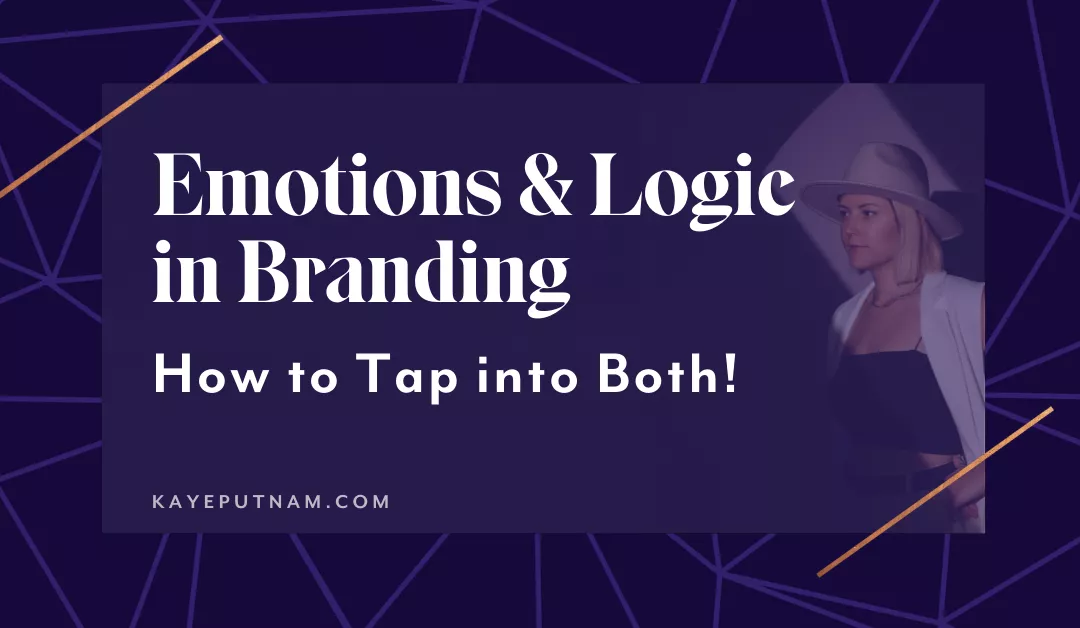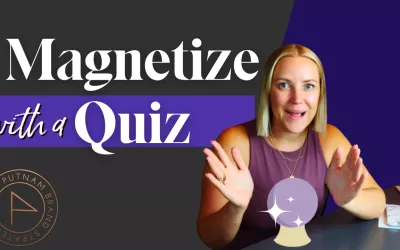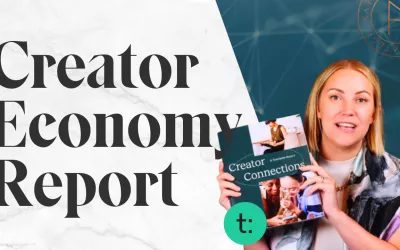All the smartest brand-builders know that humans make buying decisions emotionally.*
So it’s super-important that we don’t get stuck in the traps of “creating the best widget” or “having the cheapest offer.” (Ugh! Competing on price alone is the pits!)
And we also must avoid adding a slew of bells and whistles – for the sole reason of trying to appeal to the logical parts of our customers’ brains. (#RookieMistake!)
But there’s more to this “emotions in branding” story… Because sure, emotion dominates. But logic does ALSO play a role in buying decisions.
So the real smarties ALSO know that while emotional branding will take us quite far… it won’t take us to the finish line alone. We ALSO need to appeal to humans’ logical sides – to seal the deal and make the sale.
So in this post, I’m addressing the roles that *both* emotions AND logic play in branding and sales… the things brand-builders need to know to know about both.
I’ll cover…
- 4 specific and proven ways to speak to the emotional side; and
- 4 more ways (Yes, also specific and proven! 🤓) to appease the logical side
Ready? Let’s tap into both factors of the human decision-making equation… (You know… the equation that adds up to more revenue, and more impact for Y-O-U!)
Oh and… as per usual, if you love learning via video, you can press play. Or you can keep reading for the more detailed blog post. (Or both! Both is good, too.)
First… 4 Ways to Speak to the Emotional Side of the Decision-Making Brain
Perhaps you’ve heard of *the Harvard study that showed that 95% of our decisions are driven by our subconsciouses? Well one of the languages that our subconscious speaks fluently is emotion. So when we elicit emotions, we can be much more effective at selling.
(BTW, keep in mind that when we’re building a brand, we’re always selling to humans… Yes! Even if you have a B2B business, it’s still humans making the buying decisions! So we need to understand how humans make choices when buying, right?)
So here are four proven ways to tap into that emotional side of things…
1. Speak to their pain – and the pleasure they desire.
One way to elicit the all-important emotional response in our buyers is to acknowledge the pain that they may be feeling or experiencing – and/or the pleasure that they desire.
Here’s the reason this works so dang well…
Throughout our lives as humans, we’re basically engaged in a constant ‘back and forth.’ We’re trying to move away from pain, and move toward pleasure. It’s proven. We are wired to seek pleasure and avoid pain. (<<< Nerdy psychology article if you care to go deeper! 🤓)
And your brand can speak both of those languages (pleasure and pain).
By demonstrating that you truly understand your audience’s pains and want they want for themselves, you build trust. And when they relate, your audience tends to infer that – if you understand their pain points – you can also help solve them.
One really powerful technique for this is what my team likes to call, “joining the conversation in her head.” This means you describe very specific (I mean VERY SPECIFIC…) circumstances that feel very familiar to your ideal client. You paint a vivid picture of how she feels in that situation. Here are a couple of examples:
“Wouldn’t it be amazing to be able to plunk whatever groceries you want right down on the checkout belt at Whole Foods – without a care for where your next coaching client (paycheck!) is coming from? Here’s how to get clients on repeat – and achieve that kind of success and financial freedom in your business…”
=====
“Remember that cruise you went on solo last year? And that couple who sat at your dinner table? They laughed at something on her phone. They shared french fries. They finished each other’s sentences while talking about where they’d visited on their last cruise… Sigh. I get it. You yearn for a partner with whom to share those experiences. And you know online dating could bring that person into your life, but it’s intimidating. Well I can help you navigate it – and help you find your person!”
See the powerful specificity here? ☝🏽 Even if your prospect didn’t literally see someone sharing french fries… she still recognizes the experience and it feels VERY familiar. Because it’s specific.
(Note: While some brand-builders may shy away from appearing to “twist the knife,” the reality is that humans do tend to be more motivated to move away from pain – than toward pleasure. But if it feels off-brand for you to focus on the pain, you can lean more toward presenting the pleasure side.
But remember, selling is serving. We need to motivate our ideal clients to take action – so we can help them get the results they truly want.)
Okay now on to strategy #2, which is to…
2. Align your brand with the *identity* they have or desire.
The second way to draw out emotion is to demonstrate that your brand fits in with *WHO* the people in your audience want to be.
For example, there’s a whole suite of products in the luxury sector (Think: Rolex watches, Lamborghinis, Louis Vuitton luggage…) that do this really, really effectively. Many people buy from these brands – not because their products actually function better – but because they identify with what the brands stand for. Luxury. Abundance. Wealth.
Some who identify with this are already wealthy – and on some level they want that to be known. Others just desire wealth, and owning the “it bag” or the luxe car helps them feel connected to that.
As a brand-builder, it’s really powerful to ask yourself, “What is the identity of my ideal client now? And what does he want to change or improve about his life? What does he aspire to?”
In my own brand, my ideal clients are entrepreneurs. They desire to be both successful and aligned as business owners. That means doing work that is earning them real, meaningful amounts of money. (They want to run businesses that aren’t “just a hobby,” but rather contribute to and support their families.) At the same time, they want to be doing work that is squarely in their unique zones of genius. And they want to have impact in a way that’s meaningful and important to them.
So that intersection of meaning and money is the identity that my ideal clients hold for themselves. They are either at that point right now – or they’re aspiring to get there.
Your homework: Think about ways that you can either confirm that identity or help your audience step into that “next level” of themselves. Do this well and you’ll be speaking dead straight to that emotional decision-making center of your buyers’ brains.
Okay ready for #3…?
3. Infuse emotional images, words, and ideas into your messages.
This one may seem sort of like I’m “defining the word with the word itself” 🤣 but allow me to expand.
If we can literally portray genuinely emotional situations in our brand messages (and ideally surprise and delight our audience with that emotion!) we are winning.
Because by exposing them to the stimuli that trigger those feelings, we’ll evoke those very same emotions in our audience – the ones they must feel to truly connect to us.
Maybe we evoke wonder, surprise, or compassion. Or maybe it’s a warm fuzzy feeling of togetherness. Or in some cases, a more edgy brand might even spark disgust or anger in its messages. All of these things – especially when it’s not what your client was expecting – create an emotional response, right?
And that emotional response can motivate us into action – and/or shape our perceptions of a certain issue, product, or brand.
So how does this show up, practically speaking?
We can include really cute puppies or babies in our marketing messages – if we want to tickle some of those emotional centers. (Puppies and babies for the win! 🤣) We can put relationships on display. We can include music that underscores the corresponding feelings. Or we can just do something kind of weird and off the wall to create a little bit of that surprise and delight… the possibilities are endless.
As I write this, I can’t help but think of some of my favorite ads… those that expertly draw out specific feelings. So, I’m going to link you to a few Youtube videos to inspire you.
(Hey though… First, promise me you won’t get lost down a Youtube rabbit hole? 🤨 Okay cool. Come on back to this article after you watch these…)
- This one from Samsung puts a special relationship in the spotlight – and we feel connected.
- This one from Always pisses us off – and we feel motivated to be better – and be part of a solution.
- This one from Audi sure is unexpected. It’s hilarious and surprising – and it makes us re-think some things.
So good, right? (I’m not crying, you’re crying!) Okay on to the last of the four “emotional” strategies…
4. Tell stories about individual humans.
The fourth way to add more of this all-important emotional resonance to your brand is to tell stories about individual people.
This technique is also rooted in science – specifically in psychology. Studies have shown that listening to stories prompts the release of the neurochemical called oxytocin. (It literally sparks trust and familiarity!) And science also shows us that hearing stories triggers the same areas of our brains to light right up – as if we were experiencing the events of the stories first-hand.
So, in other words… Stories really do elicit emotions in us.
And here’s the real key to this… Tell stories about specific humans!
Don’t just tell us you’ve worked with “hundreds of clients,” or have ”thousands of happy customers.” Tell individual stories about some of your best clients or customers. This is the way to create very emotional responses in your audience.
So tell us about the client who tripled her revenue in two years – and was able to retire her husband from his very physically-demanding job that was putting him in danger. (We’ll be in awe, feel fiercely protective, and want those kinds of results for our families.)
Tell us about your Aunt Mildred who started a second career at age 57. (We’ll relate and feel deeeeep in our bones that it’s never too late to do something new!)
Tell us how you lost your job – and then decided to start your business. (We’ll feel the heat rise in our own faces when your boss lets you go. And we’ll also feel the triumph right along with you – when you describe the moment you hit “file” on that LLC paperwork.”)
Of course, I too loooooove to tell stories in my brand…
In this article about how I got back on track after a biiiigggggg slump, I interwove a few significant ones from my own business and life.
(One story finds me in a cramped hotel room feeling sorry for myself. 😂 Another story finds me triumphantly waving a flag on Everest base camp…yes, seriously! And yet a third story details how I emerged from said hotel-room-induced slump – and had my best quarter ever…This particular set of stories continues to be one of the most powerful ones that I leverage in my brand.)
So yeah. Story sells!
So those are four powerful ways to turn up the emotion in your brand – so people are more likely to pay attention – and buy from you!
Now let’s turn to the other side of the coin, shall we? Read on, because we’re headed over to the left side of the brain…
Want to save this article for reference? Pin it to your business or branding boards!📌

Pin this article to reference later! 📌
4 Ways to Speak to the Logical Side (& Seal the deal!)
Once someone makes an emotional connection with your brand, they still desire logic and facts to fully trust you – and to feel good about their decision to buy. So we don’t want to completely leave out the “left-brained reasons” to believe in your brand!
(Fun fact: Humans usually seek the logical rationale that they need to feel good about the buying decision riiiiiiiiiight before they make that final commitment… Right before they hit that ‘buy button’ or pull out their credit card. This is why you’ll often see expert marketers place stats, testimonials, etc. right on or near the checkout page!)
So let’s talk about four ways that you can speak to that logical side… so that your ideal clients or customers can back up that emotional decision they just made.
1. Cite statistics, numbers and/or research.
To reinforce what a good and safe decision this is (and to seal the deal!), it’s a great idea to include research, statistics or numbers that demonstrate your points. Our brains perceive things that are quantifiable as very concrete – and they help amp up the trust factor.
Have there been scientific studies that prove that meditation will touch and improve every aspect of your life? Cite them on your meditation course’s sales page.
Do you have a ‘4.92 out of 5’ rating on a well-known e-commerce site? Yes! Use that!
You know the average user of your product saves 28% on their energy bill in the first three months? Amazing. Don’t leave that out!
Has a respected scientist or celebrity endorsed what you’re selling? (Even if it wasn’t you specifically, they’ve endorsed your industry or your type of product, so you’re good.)
These very tangible and measurable stats – and/or trusted, validated third-party evidence – will help your buyer feel great about their decision to pull the trigger and buy!
2. Highlight features and deliverables.
Guess what? NOW you get to really showcase those features and deliverables.
In the beginning, when we’re first connecting with new potential buyers, the number of modules your course has just isn’t going to hook them in. But now, when they’re about to buy, it’s reassuring to know there are eight modules – not just two. 🤓 So now it’s time to fill in those details as needed.
Or maybe one of your product’s features is that it’s 100% vegan, organic and/or GMO-free. It’s time to present that info.
(I know I personally can recall thinking to myself… “Oh good. AND it’s even organic. Now I feel extra good about adding it to the cart!)
If you’re running a service-based business, this is the time to talk about what the client is actually going to get when they invest. What are the actual deliverables that make up your service? (Five posts a week? Two hours of engagement activity?) It’s probably not the feel-good thing that your ideal client is truly driven by, but she still wants to know what she’s getting for her money. So tell her!
Okay, on to another powerful way to speak to the logical side…
3. Remove risk (or perceived risk).
Again, to finalize the sales, your buyer needs to feel this is a smart decision – and a *safe* one! You can remove perceived risk – and therefore encourage the commitment – in a variety of ways.
You can demonstrate previous results. (This one can work really well in conjunction with telling stories, as discussed above!) Tell success stories – yours or those of past clients. Include testimonials that showcase the outcomes your product or program deliver. Show what’s possible!
Offering some type of guarantee can also go a loooooong way in making the investment feel super-safe. If it’s a product, clearly state your return policy. In internet marketing land 😉, you can offer a 30-day money-back guarantee on a course or a program.
(One sort of famous example of this is the online course that offers to double your money if you aren’t happy. That might be a bit extreme – and clearly would work better in certain situations over others – but you get the gist!)
The bottom line is that most people need that reassurance… They need to know that the decision they’re about to make is a safe one. And when we can help them feel it is, it will lead to more conversions and sales.
And, finally…
4. Demonstrate ROI (Return on Investment)
The last way (for now anyway!) of adding more logic into the equation – and to reassure our ideal client – is to demonstrate the return on investment.
Yup. All hail ROI. 🙌🏽 🙌🏽 🙌🏽
It’s really the thing that most people truly seek when considering a purchase. And it’s a mistake to assume that your audience will “calculate” that ROI themselves.
We really need to spell it out. (Errr, umm, I mean add it up for them. 🤓)
We need this to become a very logical equation. We want your prospect to think, “Okay, yes, I’m spending this money, but I’m going to get so much more value from it than the actual dollar amount that I am investing.” So communicate that ROI in any way that you can.
For example, I remember one particular testimonial from my popular Brand Advantage program. A coach who got into action during TBA signed three 1:1 coaching clients – because of the visibility she was creating with us! (That was three clients signed for $3600.00 packages… So more than $10K revenue resulted from her $497 investment in the program! 🎉)
Or perhaps you sell an e-book about extreme couponing. (So fun!) If a buyer saved $1,170.00 in the first 60 days – after buying your $47.00 ebook… that savings is also a type of ROI.
Finally, you also have the option of communicating the value of your offer – compared to other options that your ideal client could choose instead.
What if he hired a one-on-one consultant – instead of DIY-ing it by following your course? Or what would it cost for him to go to a university and learn the same material? Chances are, you can make comparisons. Point out the difference in ROI – as compared to substitute offers, competitor offers, or even with taking no action at all.
So there you have them: four emotional ways *and* four logical ways that you can increase people’s trust and willingness to buy into (and from!) your brand.
To recap…
You can tap into the emotional part of the equation by…
✔️ Speaking to the pain and the pleasure
✔️ Aligning your brand and messages with the identity your audience desires
✔️ Infuse everything with emotional images, words, ideas…
✔️ Tell stories about specific humans!
And don’t ignore the logical side of our brains. Consider these strategies…
✔️ Cite stats, numbers, and research when you have them!
✔️ Clearly highlight features and deliverables (after you make the emotional connection!)
✔️ Remove the perceived risk
✔️ Demonstrate that ROI, baby! 🤣
So which one(s) of these will you use in your brand and business – to earn more sales? Let me know in the comments below. I’d love to hear what you’re going to leverage.




